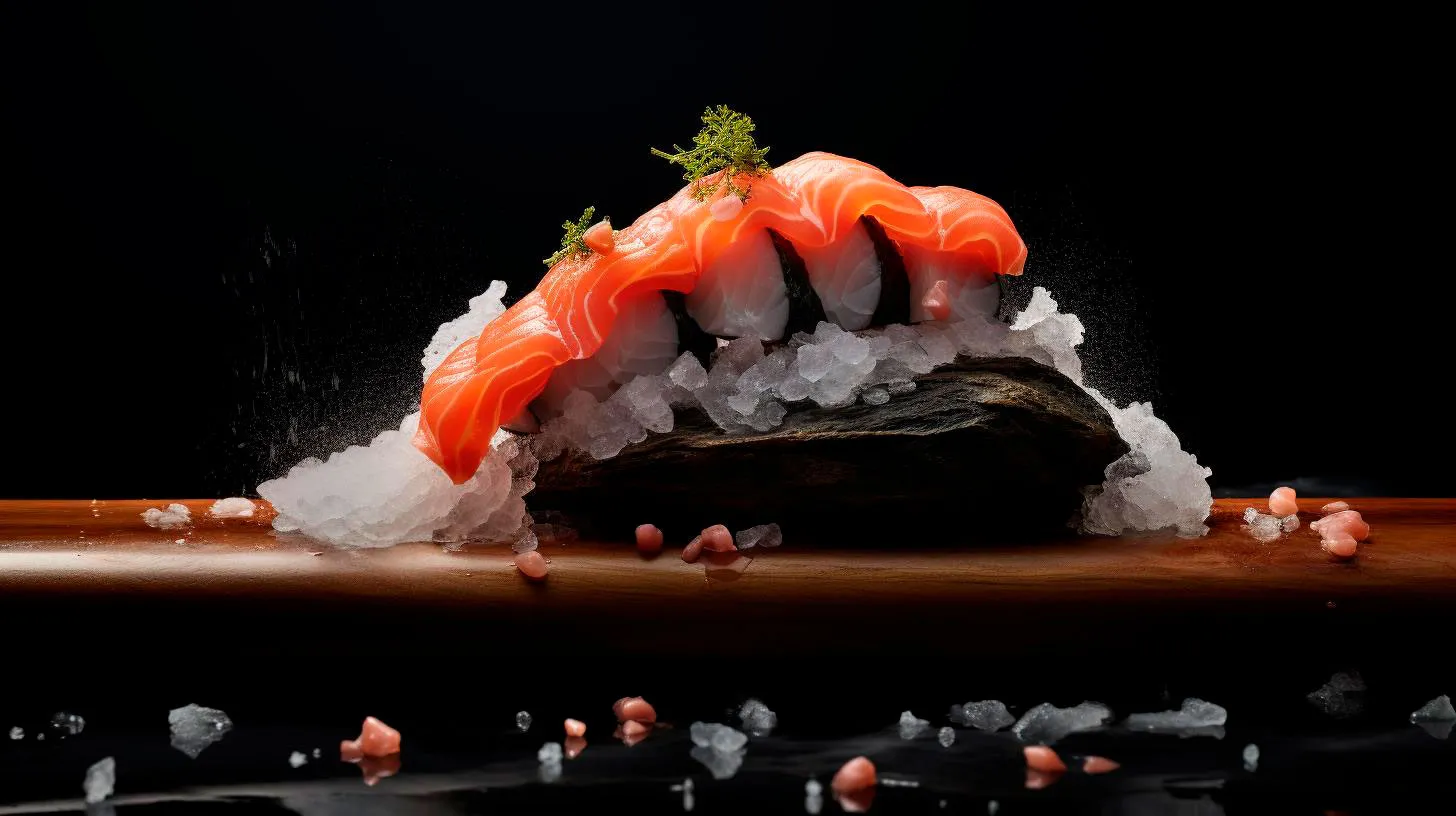Unraveling the Mystery Behind the Fascinating Pickled Ginger Controversy
In this article, we will dive into the controversy surrounding this fascinating condiment and uncover the truth behind its health benefits and potential drawbacks.
The Origins of Pickled Ginger
Pickled ginger has a long history that can be traced back to ancient China. It was originally used medicinally for its healing properties, such as easing digestion and reducing nausea. Over time, it made its way to Japan, where it became a popular accompaniment to sushi. Today, pickled ginger is enjoyed worldwide for its unique flavor and refreshing qualities.
The Health Benefits of Pickled Ginger
While pickled ginger is often praised for its taste and culinary uses, it also boasts several health benefits that make it a valuable addition to any diet. Here are some of the key advantages of consuming pickled ginger:
- Digestive Aid: Pickled ginger contains active compounds that can help stimulate digestion and relieve gastrointestinal discomfort. It is particularly effective in reducing nausea and vomiting, making it a popular remedy for motion sickness and morning sickness.
- Anti-Inflammatory Properties: Research has shown that pickled ginger possesses anti-inflammatory properties, thanks to its high content of gingerol, a bioactive compound. Regular consumption of pickled ginger may help reduce chronic inflammation and alleviate symptoms associated with inflammatory conditions.
- Antioxidant Boost: Pickled ginger contains antioxidants that help combat oxidative stress and protect the body against damage from free radicals. These antioxidants may contribute to overall health and well-being.
- Immune System Support: The immune-boosting properties of ginger are well-known. Pickled ginger can provide a dose of immune-supporting nutrients, vitamins, and minerals that help strengthen the body’s defense against infections and diseases.
The Controversy Surrounding Pickled Ginger
Despite its numerous health benefits, pickled ginger has also garnered some controversy within the health and wellness sphere. Critics argue that the potentially high sodium content and artificial additives used in some commercially-produced pickled ginger products may outweigh its positive attributes. However, it’s essential to consider that not all pickled ginger is created equal.
To fully enjoy the health benefits of pickled ginger while minimizing potential drawbacks, it’s recommended to opt for organic and naturally pickled ginger varieties. These options generally have a lower sodium content and avoid the use of artificial additives or preservatives. Reading product labels and choosing reputable brands can help ensure you make a more conscious and informed choice.
Key Takeaways
Pickled ginger is a fascinating condiment that has been the subject of debate in various culinary and health circles. To summarize, here are the key takeaways:
- Pickled ginger has a rich history and is widely enjoyed in Asian cuisine, particularly with sushi and sashimi.
- Pickled ginger offers several health benefits, including aiding digestion, reducing inflammation, providing antioxidants, and supporting the immune system.
- Not all pickled ginger is the same. It’s crucial to choose organic and naturally pickled ginger options to minimize potential drawbacks such as excessive sodium or artificial additives.
- Pickled ginger can be a flavorful and healthy addition to your diet when consumed in moderation and as part of a balanced meal plan.
In conclusion, pickled ginger sparks both curiosity and controversy. By understanding its origins, health benefits, and potential drawbacks, we can make informed decisions about including this intriguing condiment in our culinary adventures. Whether you’re a sushi enthusiast or simply a food lover, pickled ginger offers a unique and refreshing experience worth exploring.
Exploring the Polarizing Opinions on Pickled Ginger
In this article, we will delve into the polarizing opinions surrounding pickled ginger, exploring its origins, health benefits, and various uses in the kitchen.
The Origins of Pickled Ginger
The history of pickled ginger can be traced back to ancient China, where it was initially used for its medicinal properties. The process of pickling ginger involves preserving it in a vinegar solution, which not only enhances its flavor but also extends its shelf life. Over time, pickled ginger made its way to Japan, where it became an integral part of traditional Japanese cuisine, especially when served alongside sushi.
The Flavor Profile
Pickled ginger has a unique and powerful flavor that can range from pleasantly sweet to intensely tangy. The pickling process takes away the spiciness of fresh ginger, resulting in a milder taste. The distinct pink color is achieved by soaking the ginger in a vinegar-based liquid, giving it a visually appealing aspect when served on a plate alongside sushi or other dishes.
Health Benefits of Pickled Ginger
- Rich in antioxidants: Pickled ginger contains antioxidants, which help protect the body against damage from free radicals.
- Nausea relief: Ginger has long been known for its ability to alleviate nausea, making pickled ginger a popular choice for those suffering from motion sickness or morning sickness.
- Improved digestion: The enzymes in pickled ginger can aid in digestion, reducing bloating and discomfort after a meal.
- Anti-inflammatory properties: Ginger, in general, has anti-inflammatory characteristics, and pickled ginger is no exception. It may help reduce inflammation in the body and potentially alleviate symptoms of arthritis.
The Pickled Ginger Debate
While pickled ginger is adored by many, it certainly has its fair share of detractors. Here, we explore both sides of the divide:
The Fans
- Complements sushi: Many sushi enthusiasts argue that pickled ginger perfectly complements the flavors of sushi, helping to cleanse the palate in between bites.
- Visual appeal: The vibrant pink color of pickled ginger adds an attractive touch to any plate of sushi, making it aesthetically pleasing.
- Cleansing properties: Advocates of pickled ginger claim that it serves a cleansing purpose, removing any fishy aftertaste and refreshing the taste buds.
The Critics
- Overpowering flavor: Detractors argue that the tangy taste of pickled ginger can overpower the delicate flavors of sushi, altering the dining experience.
- Artificial coloring: Some people are wary of the pink color of pickled ginger, which is often achieved with artificial coloring agents. This aspect raises concerns about potential health risks.
- Preference for fresh ginger: Those who prefer fresh ginger find pickled ginger’s milder taste and texture less appealing, missing the spiciness and crunchiness.
Conclusion
Pickled ginger’s polarizing opinions exemplify how personal preferences shape our culinary experiences. While some admire its unique flavor and visual appeal, others find it overpowering or less appealing than fresh ginger. Whether you consider yourself a fan or a skeptic, it’s clear that pickled ginger is an integral part of Japanese cuisine and adds an extra layer of complexity to many dishes. So, the next time you enjoy sushi, take a moment to ponder your stance on pickled ginger and the passionate opinions it elicits.
Remember, these perspectives on pickled ginger are not universal, as taste preferences vary among individuals. Ultimately, the choice to embrace or reject this tangy condiment rests with you.
From Sushi Staple to Divisive Condiment: Understanding the Pickled Ginger Phenomenon
In this article, we’ll delve into the fascinating journey of pickled ginger, how it has evolved over time, and why it has become such a divisive ingredient among sushi enthusiasts.
The Ancient Origins of Pickled Ginger
Pickled ginger, known as “gari” in Japanese, has been an integral part of Japanese cuisine for centuries. Its roots can be traced back to ancient China, where pickling techniques were developed as a way to preserve and enhance the flavor of food. The process of pickling involves preserving food in a solution of vinegar, salt, and sugar, which helps to develop its unique tangy and slightly sweet taste.
In Japan, pickled ginger was traditionally served alongside sushi as a palate cleanser. The sharp and refreshing flavor of ginger is believed to cleanse the palate between bites, allowing the flavors of different types of fish to be fully appreciated. Beyond its functional purpose, pickled ginger also adds a burst of color to sushi plates, making them visually appealing.
Pickled Ginger’s Rise to Popularity
As sushi gained popularity around the world, so did the appreciation for pickled ginger. It has become a common sight on sushi menus globally and is even found in supermarkets as a standalone condiment. The rise of sushi restaurants and sushi bars in Western countries helped familiarize people with its taste and encouraged them to experiment with it in various culinary creations.
Today, pickled ginger can be found in different forms, ranging from the classic pale pink slices to varieties that are dyed with natural or artificial colors. Its use has expanded beyond sushi, with some people incorporating it into salads, sandwiches, and even cocktails. However, despite its widespread popularity, pickled ginger has also become a divisive ingredient among sushi purists.
The Controversy Surrounding Pickled Ginger
For some sushi enthusiasts, pickled ginger is seen as a necessary accompaniment that enhances the overall dining experience. Its sharp and tangy flavor helps cleanse the palate between different types of sushi, allowing for a more nuanced taste exploration. Others argue that pickled ginger can overpower the delicate flavors of certain fish, diminishing their natural taste.
Furthermore, some critics argue that the pink color commonly associated with pickled ginger is a result of artificial coloring, which they find off-putting. While it’s true that some commercially produced pickled ginger contains artificial dyes, there are also natural versions available that retain the classic pale color without any artificial additives.
Key Takeaways:
- Pickled ginger, or “gari,” is an essential part of traditional Japanese cuisine.
- It serves as a palate cleanser between bites of sushi and adds visual appeal to the plate.
- Pickled ginger has gained popularity globally alongside the rise of sushi.
- Some sushi enthusiasts appreciate its ability to enhance flavors, while others believe it masks the natural taste of fish.
- There are both natural and artificially colored variations of pickled ginger available.
In conclusion, pickled ginger has come a long way from being a sushi staple to a divisive condiment. Its roots in Chinese and Japanese cuisine make it an integral part of traditional sushi dining, while its popularity has spread worldwide. Whether you consider it a necessary accompaniment or an unnecessary addition, pickled ginger remains an intriguing phenomenon that continues to spark discussions among food enthusiasts.
The Pickled Ginger Debate
In this article, we will delve into the pickled ginger debate and shed light on this controversial sushi sidekick.
What is pickled ginger?
Pickled ginger, also known as Gari, is thinly sliced young ginger that has been marinated in a mixture of vinegar, sugar, and salt. The result is a pinkish hue and distinct flavor that complements sushi well. Traditionally, pickled ginger is served alongside sushi to cleanse the palate between different kinds of rolls or fish.
The role of pickled ginger
Pickled ginger serves several purposes in the sushi-eating experience. Let’s explore its key roles:
- Palate Cleanser: Pickled ginger is believed to cleanse the palate and refresh the taste buds after each bite of sushi, especially when transitioning from one type of fish to another. Its tangy flavor helps prepare your taste buds for the next flavor sensation.
- Antibacterial Properties: Ginger has long been recognized for its antibacterial properties. The pickled version of ginger is thought to help prevent potential cross-contamination from raw fish, making it a popular addition to sushi platters.
- Subtle Flavor Enhancer: While pickled ginger is not intended to overpower the flavors of sushi, it does add a subtle tang and sweetness that can enhance the overall taste experience.
The controversy surrounding pickled ginger
Despite its long-standing tradition in sushi culture, pickled ginger has attracted controversy. Here are some key points of contention:
- Ginger Overload: Some argue that using too much pickled ginger can overpower the delicate flavors of sushi, masking the true taste of the fish or other ingredients.
- Purists vs. Adventurers: Traditional sushi purists believe that pickled ginger should only be consumed between different sushi pieces to cleanse the palate. However, some people enjoy eating it alongside each bite of sushi for added flavor.
- Authenticity: There are those who question the authenticity of pickled ginger as a traditional sushi condiment, suggesting that it was introduced mainly for the Western palate and is not a true representation of Japanese sushi culture.
Key takeaways
Now that the pickled ginger debate has been highlighted, here are the key takeaways:
- Pickled ginger adds a tangy and slightly sweet flavor to sushi.
- It serves as a palate cleanser, antibacterial agent, and subtle flavor enhancer.
- Usage and preferences differ among sushi enthusiasts.
- Traditionalists enjoy pickled ginger sparingly, while others appreciate it with each bite of sushi.
- Authenticity and traditional sushi culture are topics of debate.
Ultimately, the inclusion of pickled ginger comes down to personal preference. Whether you choose to embrace it as a traditional palate cleanser or enjoy its flavor alongside each bite of sushi, the pickled ginger debate showcases the diversity and passion within the world of sushi appreciation.
So, next time you sit down for a sushi feast, experiment with pickled ginger according to your taste buds, and let this vibrant condiment spark a lively conversation around the table.


